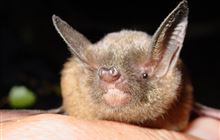Record number of bats after pest control
Archived content: This media release was accurate on the date of publication.
Introduction
Monitoring studies show that targeted pest control operations last summer have led to record survival rates for short-tailed bats in the Eglinton valley in Fiordland.Date: 06 October 2015
Monitoring studies show that targeted pest control operations last summer have led to record survival rates for short-tailed bats in the Eglinton valley in Fiordland.
DOC undertook a coordinated pest control programme in the Fiordland National Park valley last spring to combat a beech seed-fuelled rat and stoat plague over the summer.
Results show 99% of the bat population survived following the Battle for our Birds pest control operation.
This is almost twice the survival rates (50-60%) shown to occur without pest control in a beech mast (seeding) year.
DOC Conservation Services Manager Lindsay Wilson says the results show that well-timed pest control successfully countered the threat of rats and stoats as bats raised their young over the summer.
“Ninty nine percent survival is the highest result ever recorded and we also had a record 1731 bats counted leaving from one roost.
“Our long-term monitoring is showing the population of short-tailed bats in the Eglinton is stable to increasing,” says Lindsay Wilson.
“These results are very encouraging and similar to those for long-tailed bats, which show a slow but steady increase since predator control began in the valley in 2004.”
Last year under the Battle for our Birds campaign DOC used aerial 1080 for the first time in the Eglinton valley, in addition to a network of poison bait stations and traps in the lower valley, to combat rising rat numbers.
The pest control programme was designed to protect New Zealand’s most important mainland southern short-tailed bat population, as well as southern long-tailed bats and birds such as mōhua/yellowhead and South Island kākā.
The Eglinton valley near Te Anau has the only viable population of short-tailed bats on mainland South Island and is one of the only places where both species of bats remain.
Prior to pest control, long-tailed bats were shown to be in decline due to being preyed on by rats, possums and stoats.
The two bat species or pekapeka are New Zealand’s only native land mammals; both are threatened and a high priority for conservation.
Background information
DOC has monitored short-tailed bats in the Eglinton valley since 2006 and pioneered the use of PIT tags or micro-chips to count bats as they leave and return to their roosts to estimate population size.
The study of short-tailed bats through a 1080 operation last summer was the first of its kind to use this method to monitor survival, which also involved capturing a sample of bats as they returned from night-time feeding.
The 99% survival indicates pest control was effective in stopping predation. The 1% change in the numbers of bats detected was due to mostly male bats moving to other areas rather than fatalities.
No adverse effects of 1080 on bats was observed in the captured bats or at studied roosts. One dead baby bat was found with detectable 1080 levels in its muscle tissue although the cause of death is unknown.
Contact
For media enquiries contact:
Email: media@doc.govt.nz

